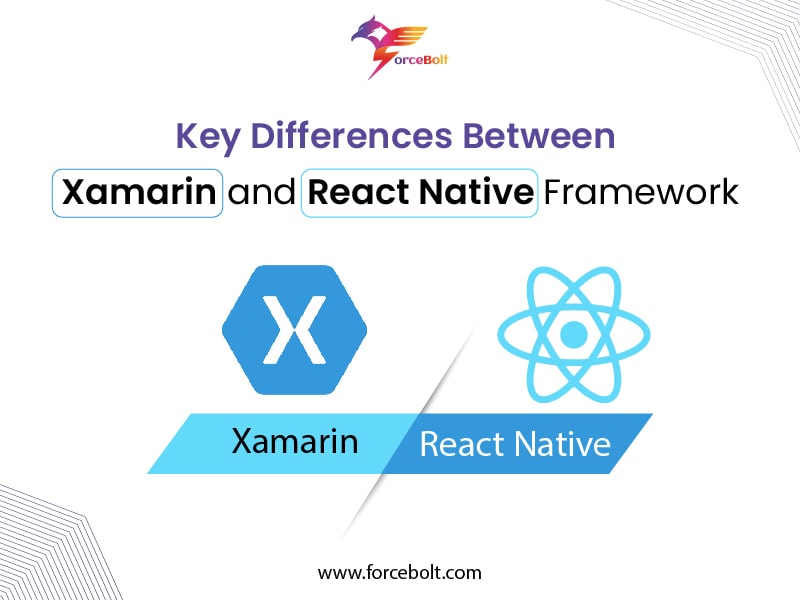Sharing is caring!
Mobile applications have become our daily entertainment tool. But developing a mobile application requires a lot of hard work. The frameworks help to speed up the development of mobile applications. React native and Xamarin are great tools that support developing mobile apps seamlessly and try to eliminate the tension for dependencies.
Let us compare the advantages and disadvantages of React Native and Xamarin.
ReactNative :
React Native is an open-source mobile application development framework created by combining Javascript and components of React. React Native is capable of developing highly functional applications for iOS and Android utilizing Facebook’s React library. It helps us in developing feature-rich UI apps, which is the key principle of React-based development.
Pros:
- It supports us in creating cross-platform mobile applications and reduces the cost and time.
- Building applications that are quick at responding and ensure dynamic performance.
Cons:
- As react native is a Javascript-based framework, it doesn’t support decimal, making it complicated to use in computation-based apps.
- The A-security application requires additional care.
Xamarin:
Xamarin is an open-source framework specially designed to develop high-performance mobile applications. This framework mainly uses JavaScript and HTML to enhance the UI of the mobile application. It mostly utilizes the concepts of the C# programming language and is introduced by Microsoft. Xamarin supports smart wearable devices and runs on Linux, Unix, and . NET. It supports the sharing of code for diverse platforms for which you need to create the application.
Pros:
- It supports multiple integrations for the application logic at various layers and supports code reclaim.
- Xamarin is based on tons of components being used.
Cons:
- The applications require a lot of time for future updates.
- Its diverse relationship nature and various device support make it difficult to administer.
Today, we will cover the differences between React Native and Xamarin. Here is the brief about all the points you must know about React Native vs. Xamarin-
Availability :
React Native is the ideal choice when it comes to availability. An open-source framework, it’s a free tool that helps you code for both Android and iOS platforms.
Microsoft’s Xamarin has a free version but limited functional features and resources. You need to lose your pocket a bit to get the enterprise version.
Underlying Technology:
React Native allows professionals to use JavaScript- the most beloved and trusted programming language that uplifts development capabilities. It lets coders write on a single application using JS, including parts of both Android & IOS with fast previews. Programmers that are qualified enough and have years of experience in Java Script language can smoothly build their mobile applications for any mobile app development company.
Xamarin utilizes C# +. Net Framework. It allows developers to reuse the maximum of the code to design iOS and Android Applications. All the applications can be programmed on Visual Studio, which has a cutting-edge editor, debugging tools, and native platform integration with Mac, iOS & Android. It helps in eliminating the need to switch between multiple platforms.
Market Share and Dominance :
Let us analyze who has the highest market share between React Native and Xamarin. React native is a popular offering of near-native performance, for which it is utilized by both enterprises and startups. To maintain their engaging online presence, premium brands like Facebook, Tesla, Skype, Ubereats, and Walmart utilize the best features of React Native.
Xamarin is ideal for brands like Honeywell, Slack, JetBlue, Cognizant, and many more to enhance their online presence.
React Native and Xamarin are both valued by humongous brands, so it’s a tie for this one.
Performance :
When it comes to performance, React-Native is admired by all. It delivers near-to-native performance. However, if you analyze the language deeper, there are a few problems like it doesn’t support 64-bit mode on Android apps, weak navigational performance, and huge app size.
Talking about Xamarin, it runs the fastest code on both Android and iOS applications. It also supports 64-bit mode and caters to excellent UI to ensure the use of native tools.
Conclusion:
Coming to an end, let’s sum up React Native, and Xamarin are both highly powerful frameworks that can be utilized to create and enhance quality applications. As we saw earlier, both frameworks have their own benefits and limitations. So the choice remains on your business requirements. We suggest you consider your technical partner’s opinion or a good react native app development company. Visit our blogs more for Tech related updates.

Akshay Dhiman
Chief Technical Officer
The Chief Operating Officer of ForceBolt and a decisive leader who possesses a wide array of technical skills and management skills to implement operational changes by working at different levels of development. Being enthusiastic and technology proficient, he understands the importance of staying up-to-date with the latest technological transformations and provides competitive, scalable and efficient solutions. He has a good command of technical language and possesses good communication skills. Being a leader makes him a good team player, and he resonates with his priorities well.













